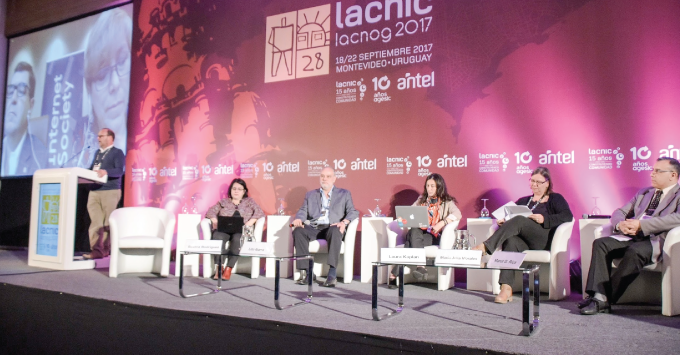There Is No Future with the Current Digital Divide
29/09/2017

As Internet connectivity grows, the digital divide widens and the hope that the Internet will become a tool that will guarantee equal opportunity for all seems a bit far from reality. This is how we might summarize the opinion of the InterCommunity panel on “The Future of the Internet: The Digital Divide” organized by the Internet Society (ISOC) during the LACNIC 28 event held in Montevideo.
In turn, each panelist emphasized that the ability to benefit from the Internet was not only determined by the network itself but also by what Internet access looks like to those who are already connected (http://bit.ly/2xzYLQ8).
Sebastián Bellagamba of ISOC mentioned a global study commissioned by the Internet Society to determine where the Internet might be headed in the next five years. Among other conclusions, the report noted concerns regarding “the threat of new divides, which would not only deepen existing differences but could also divide society as a whole.” In this sense, the ISOC report states that the digital divide will not only not be limited to Internet access, but that new digital divides will emerge from “the difference between the economic opportunities available to some but not to others.”
Lito Ibarra, member of the LACNIC Board, observed that there are three types of digital divides: a geographical divide (areas with better Internet access than others), a cultural divide (social groups better acquainted with technology) and a generational divide (the young do not take advantage of technology but instead use it exclusively for for entertainment). “We must work on each of these divides in a different yet coordinated way,” stressed Ibarra.
What can we do to leverage the Internet as a leveler of opportunity? Ibarra asked himself. “We must find each person’s strength and promote ICTs as a driver of the economy,” he replied.
For Laura Kaplan, Development and Cooperation Manager at LACNIC, the best way to close the digital divide is through education with civil society participation. It is clear that the Internet is a tool with huge potential, she said, and that we must contribute with education and inclusion projects. In this sense, she mentioned the example of the Aytic Goes Global initiative, a project that offers tools to help insert Haitians in the digital economy.
María Julia Morales, member of the ISOC Uruguay Chapter, agreed with Kaplan regarding the existence of an internal digital divide that will never be closed without education. For Morales, beyond connectivity, sustainable development is impossible in a country without education. Morales noted that varying levels of Internet connection quality result in different levels of opportunity. Therefore, she added, Internet connection and quality should be at the service of citizens and at the center of state policies.
Click for more images:
[ngg_images source=”galleries” container_ids=”4″ display_type=”photocrati-nextgen_basic_slideshow” gallery_width=”680″ gallery_height=”400″ cycle_effect=”fade” cycle_interval=”3″ show_thumbnail_link=”0″ thumbnail_link_text=”[Mostrar miniaturas]” order_by=”sortorder” order_direction=”ASC” returns=”included” maximum_entity_count=”500″]
Mauro Ríos, an Information Technology expert and chairman of ISOC Uruguay, said that providing Internet access to people does not mean opening them to the world. He mentioned a Chilean study which shows that the online life of the majority of people living in vulnerable socio-economic conditions is almost identical to their real one. “Seven out of ten of their online contacts live in their physical area of influence,” he commented.
“Access used to be seen as a universal cure that would bring opportunity to all, but this has not worked out as expected. Providing Internet access is not enough. We are not understanding the social context of the people to whom we provide access. We believe that by providing them with Internet access we are offering them opportunities. The problem is how people use this Internet access we are providing, something we do not fully understand at this point,” Ríos explained.
The panel ended with a toast to the 25th anniversary of the Internet Society.
(Free access, no subscription required)